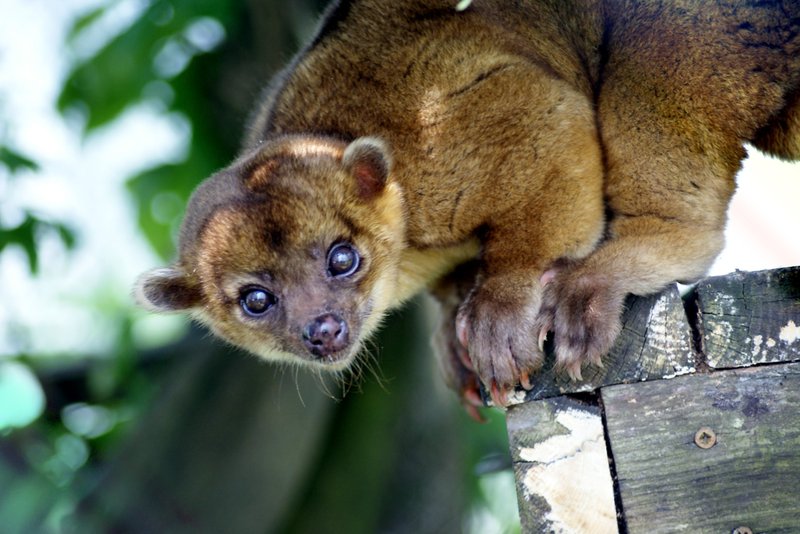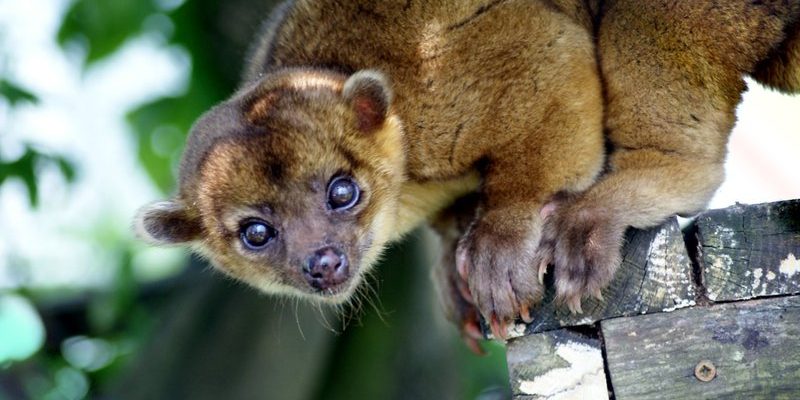
The kinkajou is a fascinating creature that often sparks curiosity among those who hear about it. Imagine a small, playful mammal that resembles a mix between a monkey and a raccoon. This adorable animal is not only a delight to watch but also plays a significant role in its ecosystem. If you’ve ever wondered what makes the kinkajou so special, you’re in for a treat!
Kinkajous are native to the tropical forests of Central and South America. They’re nocturnal, which means they’re most active at night, often frolicking through the treetops in search of food. Their fluffy fur and large, expressive eyes make them look almost like stuffed toys. But there’s much more to kinkajous than their cute appearance—they are essential contributors to their habitats.
What is a Kinkajou?
Kinkajous, also known as Potos flavus, are members of the family Procyonidae. This family also includes raccoons and coatis. Unlike many other mammals, kinkajous have a prehensile tail, which acts like a fifth limb, allowing them to grip branches as they navigate the canopy. Their agile bodies are perfectly designed for life among the trees.
These charming animals can grow up to 16 to 24 inches in length, excluding their tails, which can be equally long. They have a thick coat of fur that is typically golden-brown or yellowish, giving them excellent camouflage among the leaves. Their large eyes are adapted to low light, helping them see well during their active nighttime hours.
Habitat and Distribution
The kinkajou predominantly resides in the lush, tropical forests of Central and South America. You’ll find them in countries like Costa Rica, Panama, Brazil, and Colombia. These forests provide the perfect environment for kinkajous, offering plenty of trees for climbing and abundant fruit for munching.
Interestingly, kinkajous prefer mature forests rather than secondary growth, showing a specific taste for humidity and biodiversity. They thrive in areas with a rich understory, enabling them to find food and shelter easily. By living in these densely forested areas, they play a vital role in seed dispersal, helping maintain the health of their ecosystem.
Diet and Feeding Habits
Kinkajous are primarily frugivorous, meaning they predominantly eat fruits. They have a particular fondness for figs, which make up a large part of their diet. However, they’re not picky eaters. Besides fruits, kinkajous also consume flowers, nectar, and even insects. They have a long, thin tongue that allows them to extract nectar from flowers, much like a hummingbird!
Their love for fruits makes them essential for the forest’s health. By eating fruits and then excreting the seeds, they help to propagate various plant species. It’s a win-win situation; they get delicious snacks, and the forest gets new plants! This ecological role cannot be overstated, as it enhances biodiversity and encourages the growth of new trees.
Behavior and Social Structure
When it comes to social structure, kinkajous are generally solitary but can be found in small groups, especially during foraging or when resting. Their vocalizations are quite fascinating; they communicate with a range of sounds, including whistles, growls, and even barks. Each sound serves a different purpose, from alerting others to potential danger to social bonding.
Since they are nocturnal, kinkajous spend their nights exploring, playing, and feeding. They’re known for their playful antics, often swinging from branch to branch and engaging in mock fights with one another. This playful behavior isn’t just for fun; it helps them develop social skills and learn to navigate their environment effectively.
Reproduction and Lifespan
Kinkajous are typically monogamous, forming long-term bonds with a mate. The mating season occurs once a year, and after a gestation period of about 120 days, the female gives birth to a single offspring. The baby kinkajou is born blind and helpless, relying entirely on its mother for care.
As they grow, the young kinkajous start to explore their surroundings, often clinging tightly to their mother’s back. This nurturing phase lasts for several months, during which the mother teaches her young about climbing and foraging. Kinkajous reach sexual maturity around 2 to 3 years of age and can live up to 20 years or more in the wild.
Conservation Status
Unfortunately, the kinkajou faces several threats, primarily due to habitat loss from deforestation and illegal hunting. As humans encroach on their natural habitats, these adorable mammals find it increasingly difficult to survive. Conservation efforts are crucial to protect their populations and the delicate ecosystems they inhabit.
Organizations working to conserve kinkajous are focused on reforestation, creating protected areas, and educating local communities about the importance of preserving wildlife. Every effort counts, as kinkajous play an integral role in their ecosystem. By protecting them, we also safeguard the health of the forests and the countless species that call them home.
Interesting Facts About Kinkajous
| Scientific Name: | Potos flavus |
| Size: | 16–24 inches (excluding tail) |
| Weight: | 3–10 pounds |
| Habitat: | Tropical forests of Central and South America |
| Diet: | Fruits, flowers, nectar, insects |
| Lifespan: | Up to 20 years in the wild |
| Behavior: | Nocturnal, social, and playful |
FAQ
Are kinkajous good pets?
While kinkajous may seem like adorable pets, they require a lot of care and attention. They are nocturnal animals and are active at night, making them less suitable for typical household life. Additionally, they can be quite mischievous and need ample space to explore. It’s essential to research thoroughly and consider adopting from a reputable source if you’re thinking about bringing a kinkajou into your home.
What do kinkajous sound like?
Kinkajous are known for their wide range of vocalizations. They can produce soft whistles, loud barks, and even growls. Each sound serves a communication purpose, whether to signal danger or engage with their mate or offspring. If you’ve ever heard a kinkajou at night, you might have felt like they were having a lively conversation among themselves!
How do kinkajous help the environment?
Kinkajous play a vital role in their ecosystems by aiding in seed dispersal. When they eat fruits, they excrete the seeds in different locations, which helps with plant growth. This process enhances biodiversity and contributes to the overall health of tropical forests. By maintaining healthy populations of kinkajous, we support vibrant ecosystems.
Can kinkajous see in the dark?
Yes! Kinkajous have large eyes that are adapted for low-light conditions. Their excellent night vision allows them to navigate through the trees effortlessly as they hunt for food at night. This adaptation is crucial for their survival in the dense canopies of their tropical habitat.
What other animals are kinkajous related to?
Kinkajous belong to the family Procyonidae, which includes raccoons, coatis, and olingos. Despite their playful appearance, they share a close genetic relationship with these animals, exhibiting similar traits in behavior and diet. This connection demonstrates the fascinating diversity within the animal kingdom.
How can I contribute to kinkajou conservation?
There are several ways you can help kinkajous and their habitats. Supporting reputable conservation organizations, spreading awareness about their plight, and advocating for sustainable practices can make a significant impact. Moreover, consider responsible tourism that promotes conservation efforts in Central and South America, ensuring the preservation of kinkajous and their beautiful forests.
What is a kinkajou’s favorite food?
Kinkajous have a particular fondness for figs, which are often abundant in their tropical habitats. However, they also enjoy a variety of fruits such as apples, bananas, and berries, as well as nectar and flowers. Their diverse diet helps maintain their health and supports their vital role in seed dispersal within their ecosystem.
Are kinkajous endangered?
Kinkajous are currently not classified as endangered, but they are facing significant threats due to habitat loss and hunting. Conservation programs are essential to monitor their populations and ensure their future survival. It’s crucial to support efforts aimed at preserving their natural habitats and raising awareness about their importance in the ecosystem.
Do kinkajous have any predators?
In the wild, kinkajous face threats from various predators such as large birds of prey, snakes, and wild cats. However, their primary defense is their nocturnal lifestyle, allowing them to evade many predators. Their ability to climb high in trees further helps them stay out of reach. It’s a tough life in the wild, but their agile nature keeps them one step ahead!
What makes kinkajous unique?
Kinkajous are unique due to their playful behavior, nocturnal habits, and prehensile tails, which facilitate climbing. They’re often described as “honey bears” due to their love for nectar, showcasing their unique place in the animal kingdom. This fascinating blend of traits, along with their environmental importance, makes them truly special creatures in the ecosystem.

